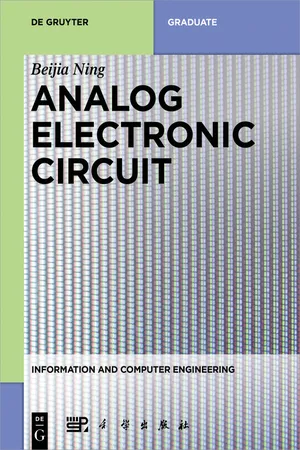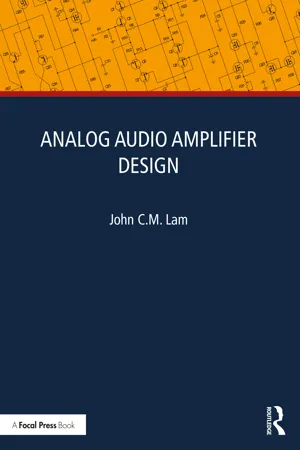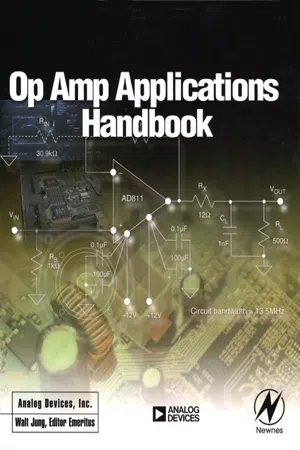Physics
Ideal Op Amp
An ideal op amp is a theoretical electronic component with infinite input impedance, zero output impedance, infinite open-loop gain, and zero offset voltage. It is often used as a building block in electronic circuits for amplification, filtering, and signal processing due to its simplified and predictable behavior. However, real op amps have limitations that deviate from these ideal characteristics.
Written by Perlego with AI-assistance
Related key terms
Related key terms
1 of 4
Related key terms
1 of 3
11 Key excerpts on "Ideal Op Amp"
- eBook - ePub
- Beijia Ning, Beijia Ning(Authors)
- 2018(Publication Date)
- De Gruyter(Publisher)
Nowadays, manufacturers produce a large number, several hundred most probably, of various op-amps; therefore, even simple enumeration of their parameters and characteristics, such as input or output resistance, is a certain problem. It is difficult to orient designers in this abundance of types and parameters without the necessary structured knowledge about them. Therefore, the correct and reasonable choice of an op-amp for some device should include the cost, reliability and quality of the device under development.5.2Fundamentals of op-amp
An operational amplifier is a differential amplifier with a very high gain, featuring in high input impedance and low output impedance. There are many functional circuits built by op-amps, which are widely used to deal with analog signals. Moreover, an opamp may contain multiple differential amplifier stages to achieve very high voltage gain [1 , 9 ].For applications of op-amps, the common opinion is that it is not necessary to know their internal circuits; on the contrary, it is sufficient to be aware of the input and output characteristics. This way of thinking is not rare. For example, computer manufacturers scarcely know the internal structure of the Pentium microprocessor, but this does not prevent them from designing satisfactory computers. Op-amps can be considered as circuit elements like resistors or capacitors, with only a somewhat more complex internal structure.Nevertheless, the system modeling, involving the knowledge of the structure, structural relations and the principles of construction of various op-amps, allows engineers to design more competently. However, this is beyond the coverage of the textbook.So, in the following sections, the basic knowledge of op-amps will be examined as a black box and the focus will be on the set up of the network to meet design requirements.A basic op-amp is shown in Fig. 5.1 with two input terminals and one output terminal. The input terminal indicated by a plus (+) sign results in an output with the same polarity as that of input, while the one with minus (−) opposite polarity of input signal [1 , 9 , 11 , 16 ].Note that in Fig. 5.1 , the terminals of power supply and other auxiliary pins are omitted for simplicity.Fig. 5.1: Basic op-amp.1. Single-ended input mode
- eBook - ePub
- John C.M. Lam(Author)
- 2024(Publication Date)
- Focal Press(Publisher)
4Operational amplifiersDOI: 10.4324/9781003369462-44.1 Introduction
Figure 4.1 shows a diagram of an operational amplifier, which is often called an op-amp. An opamp has two inputs (inverted and non-inverted), one output, and dual power supply terminals. Some op-amps also offer two more terminals for connecting a trimmer to reduce dc offset voltage. Op-amp is a versatile electronic device that is found in almost every electronic application. A good understanding of op-amp and its applications is essential to perform the design work for audio and linear application.Diagram of an operational amplifier (op-amp)Figure4.1An ideal op-amp has the following properties [1 –3 ]:- infinite differential voltage gain;
- infinite input impedance;
- zero output impedance;
- zero input offset voltage;
- zero input bias current.
Therefore, the differential inputs of an ideal op-amp must be zero, i.e., V+ ‒ V- = 0, and the input current is also zero, i.e., I+ = 0, I- = 0. We can easily see why these must be true. If Av denotes the differential voltage gain of the op-amp, the output is given asVout =(V+-V-)AvFrom a mathematical point of view, if the differential voltage gain Av approaches infinite, the output will also approach infinite. In order to confine the output to a finite value for practical use, the term (V+ ‒ V-) must be zero. In other words, the non-inverted input and inverted input must be equal at all times, V+ = V-. On the other hand, since the input impedance is infinite, it can be easily understood that the input current must be zero, I+ = 0 and I- = 0. These properties lead to the so-called golden rules for op-amp application analysis:- non-inverted and inverted inputs are equal at all times, V+ = V-
- zero input current at all times, I+ = 0 and I- = 0
Even though an ideal op-amp does not exist in real life, the golden rules help tremendously to simplify the op-amp application analysis. After all, the results that are determined by applying the golden rules are sufficiently accurate for almost all applications. In the following, some audio and linear applications using an op-amp are discussed. - David Terrell(Author)
- 1996(Publication Date)
- Newnes(Publisher)
Let us now examine some of the basic characteristics of an ideal operational amplifier. By focusing on ideal performance, we are freed from many complexities associated with nonideal performance. For many real applications, the ideal characteristics may be used to analyze and even design op amp circuits. In more demanding cases, however, we must include other operating characteristics which are viewed as deviations from the ideal.The basic schematic symbol for an Ideal Op Amp is shown in Figure 1.12 . It has the inverting and noninverting inputs labeled (−) and (+), respectively, and has a single output. Although it certainly must have power supply connections, they are not generally included on schematic diagrams.FIGURE 1.12 The basic operational amplifier symbol.1.3.1 Differential Voltage Gain
The differential voltage gain is the amount of amplification given to voltage appearing between the input terminals. In the case of the Ideal Op Amp, the differential voltage gain is infinity. You will recall from your studies of transistor amplifiers that the output from an amplifier is limited by the magnitude of the DC supply voltage. If an attempt is made to obtain greater outputs, then the output is clipped or limited at the maximum or minimum levels. Since the op amp has such extreme (infinite) gain this means that with even the smallest input signal the output will be driven to its limits (typically ±15 volts for Ideal Op Amps).This is an important concept so be sure to appreciate what is being said. To further clarify the concept let us compare the Ideal Op Amp with a more familiar amplifier. We will suppose that the familiar amplifier has a differential voltage gain of 5 and has output limits of ±15 volts. You will recall that the output voltage (v o- eBook - ePub
Introduction to Energy, Renewable Energy and Electrical Engineering
Essentials for Engineering Science (STEM) Professionals and Students
- Ewald F. Fuchs, Heidi A. Fuchs(Authors)
- 2020(Publication Date)
- Wiley(Publisher)
8 Operational Amplifiers8.1 Introduction
The operational (OP) amplifier is a basic building block for the design of analog electronic systems such as feedback control circuits [1 ], where the angular velocity ω m (t), angular position θ m (t) = ∫ω m (t)dt, current i(t), and torque T(t) must be controlled. An OP amplifier with no external circuitry is a voltage amplifier with a very high open‐loop voltage gain that ideally approaches infinity A v → ∞, as shown in a symbolic manner in Figure 8.1 . Note that input/output voltages can be either time varying or time independent, and they can be either periodic or nonperiodic.OP amplifiers are integrated circuits (IC), which can be purchased off the shelf, and they contain transistors, diodes, resistors, and capacitors all fabricated on a single silicon chip. Inductors are bulky and are mostly avoided in OP amplifier designs. The analog electronic circuit of Figure 8.1 has two inputs: a negative (v − ) and a positive (v + ) input supplied by the voltages v in1 and v in2 , respectively, whose difference in voltage (v in2 − v in1 ) produces an output signal voltage v out that is a replica of the input voltage difference. The two‐input voltage approach is useful because stray signals/electric noise that appear on both inputs are cancelled, and only the voltage difference is amplified. An OP amplifier is also called a differential amplifier because the output voltage is a voltage that is A v times the voltage difference between the two inputs. During the past half century, OP amplifiers have been refined and improved to the extent that they have nearly ideal properties, and therefore we discuss in this textbook the performance of Ideal Op Amplifiers only. The understanding of nonideal properties of OP amplifiers requires detailed electronic knowledge [2 - eBook - ePub
- Clive Maxfield, John Bird, Tim Williams, Walt Kester, Dan Bensky(Authors)
- 2011(Publication Date)
- Newnes(Publisher)
Chapter 11 Analog Electronics Mike Tooley and Tim WilliamsThe operational amplifier is the basic building block for analog circuits, and progress in op-amp performance is the “litmus test” for analog IC electronics technology in much the same way as progress in memory devices is for digital electronics technology. This chapter will be devoted to op-amps and comparators, with a tailpiece on voltage references.11.1 Operational Amplifiers Defined
Operational amplifiers (Figure 11.1 ) are analog integrated circuits designed for linear amplification that offer near-ideal characteristics (virtually infinite voltage gain and input resistance coupled with low output resistance and wide bandwidth).Figure 11.1 A typical operational amplifier. This device is supplied in an 8-pin dual-in-line (DIL) package. It has a JFET input stage and produces a typical open-loop voltage gain of 200,000Operational amplifiers can be thought of as universal “gain blocks” to which external components are added in order to define their function within a circuit. By adding two resistors, we can produce an amplifier having a precisely defined gain. Alternatively, with two resistors and two capacitors we can produce a simple band-pass filter. From this you might begin to suspect that operational amplifiers are really easy to use. The good news is that they are!11.2 Symbols and Connections
The symbol for an operational amplifier is shown in Figure 11.2 . There are a few things to note about this. The device has two inputs and one output and no common connection. Furthermore, we often don’t show the supply connections—it is often clearer to leave them out of the circuit altogether!Figure 11.2 Symbol for an operational amplifierIn Figure 11.2 , one of the inputs is marked “-” and the other is marked “+”. These polarity markings have nothing to do with the supply connections—they indicate the overall phase shift between each input and the output. The “+” sign indicates zero phase shift while the “-” sign indicates 180° phase shift. Since 180° phase shift produces an inverted waveform, the “-” input is often referred to as the inverting input . Similarly, the “+” input is known as the non-inverting - eBook - ePub
- Walt Jung(Author)
- 2004(Publication Date)
- Newnes(Publisher)
1 At this point, note that there is no need for concern with any actual technology to implement the amplifier. Attention is focused more on the behavioral nature of this building block device.Figure 1-1 The Ideal Op Amp and its attributesAn op amp processes small, differential mode signals appearing between its two inputs, developing a single-ended output signal referred to a power supply common terminal. Summaries of the various Ideal Op Amp attributes are given in Figure 1-1 . While real op amps will depart from these ideal attributes, it is very helpful for first-level understanding of op amp behavior to consider these features. Further, although these initial discussions talk in idealistic terms, they are also flavored by pointed mention of typical “real world” specifications—for a beginning perspective.It is also worth noting that this op amp is shown with five terminals, a number that happens to be a minimum for real devices. While some single op amps may have more than five terminals (to support such functions as frequency compensation, for example), none will ever have fewer. By contrast, those elusive Ideal Op Amps don’t require power, and symbolically function with just four pins.2Ideal Op Amp Attributes
An Ideal Op Amp has infinite gain for differential input signals. In practice, real devices will have quite high gain (also called open-loop gain ) but this gain won’t necessarily be precisely known. In terms of specifications, gain is measured in terms of VOUT /VIN , and is given in V/V, the dimensionless numeric gain. More often, however, gain is expressed in decibel terms (dB), which is mathematically dB = 20 • log (numeric gain). For example, a numeric gain of 1 million (106 V/V) is equivalent to a 120 dB gain. Gains of 100 dB − 130 dB are common for precision op amps, while high speed devices may have gains in the 60 dB − 70 dB range.Also, an Ideal Op Amp has zero gain for signals common to both inputs, that is, common-mode (CM) signals. Or, stated in terms of the rejection for these common-mode signals, an Ideal Op Amp has infinite CM rejection - eBook - ePub
- Analog Devices Inc. Analog Devices Inc. Engineeri, Hank Zumbahlen(Authors)
- 2011(Publication Date)
- Newnes(Publisher)
The name “op amp” is the standard abbreviation for operational amplifier. This name comes from the early days of amplifier design, when the op amp was used in analog computers. (Yes, the first computers were analog in nature, rather than digital.) When the basic amplifier was used with a few external components, various mathematical “operations” could be performed. One of the primary uses of analog computers was during World War II, when they were used for plotting ordinance trajectories.Voltage Feedback Model
The classic model of the voltage feedback (VFB) op amp incorporates the following characteristics:1. Infinite input impedance 2. Infinite bandwidth 3. Infinite gain 4. Zero output impedance 5. Zero power consumptionNone of these can be actually realized, of course. How close we come to these ideals determines the quality of the op amp.This is referred to as the VFB model. This type of op amp comprises nearly all op amps below 10 MHz bandwidth and on the order of 90% of those with higher bandwidths (Figure 1-2 ).Figure 1-2: The attributes of an Ideal Op AmpBasic Operation
The basic operation of the op amp can be easily summarized. First we assume that there is a portion of the output that is feedback to the inverting terminal to establish the fixed gain for the amplifier. This is negative feedback. Any differential voltage across the input terminals of the op amp is multiplied by the amplifier’s open-loop gain. If the magnitude of this differential voltage is more positive on the inverting (−) terminal than on the non-inverting (+) terminal, the output will go more negative. If the magnitude of the differential voltage is more positive on the non-inverting (+) terminal than on the inverting (−) terminal, the output voltage will become more positive. The open-loop gain of the amplifier will attempt to force the differential voltage to zero. As long as the inouts and output stays in the operational range of the amplifier, it will keep the differential voltage at zero and the output will be the input voltage multiplied by the gain set by the feedback. Note from this that the inputs respond to differential-mode not common-mode input voltage: - Ed Lipiansky(Author)
- 2012(Publication Date)
- Wiley-IEEE Press(Publisher)
A voltage source models the offset voltage of the amplifier. The offset voltage (V OS) of the op amp is the voltage that is required to apply across its inputs to obtain a 0 V output with the op amp in an open-loop condition. Differential impedance appears across both op amp inputs and common mode impedance appears between the inputs and ground. This impedance models the finite common mode the real op amp has. Figure 5.30 depicts an op amp model with some real electrical parameters. Figure 5.30 Model of a real operational amplifier. The input stage has two AC current sources (I N) and an AC voltage source (V N) that model noise components that unavoidably exist in the op amp. Finally, for the input imperfections, we have to mention that both bias currents and offset voltages vary or drift with temperature variations. Manufacturers usually specify these parameters at one temperature, for example, at 25°C and at a range of temperatures, such as − 40°C to 85°C. Let us now talk about the output stage of the real op amp. The output of the op amp has a nonzero and finite output resistance (R o), which is modeled in series with the output generator A OL (Fig. 5.30). Generator A OL models the finite nature of the op amp open-loop gain. In actuality A OL is really large, but it is not infinite. The op amp open-loop gain is also a function of frequency, and it is usually modeled with a capacitor hanging from the output of the op amp to ground. This RC network at the output of the op amp is also referred to as the op amp single pole approximation. The op amp manufacturer specifies the device behavior with frequency with the open-loop gain bandwidth and with the op amp gain-bandwidth product. Both of these parameters model the frequency behavior of the op amp under small signal excitation. A small signal for an op amp is a signal whose amplitude is about one order of magnitude smaller that its supply voltage- eBook - ePub
- Darren Ashby, Bonnie Baker, Ian Hickman, Walt Kester, Robert Pease, Tim Williams, Bob Zeidman(Authors)
- 2011(Publication Date)
- Newnes(Publisher)
Chapter 19
Op-Amps
Darren Ashby, Bruce Carter, Ron Mancini, Tim Williams and Bonnie Baker19.1 The Magical Mysterious Op-Amp
An operational amplifier, often called an op-amp , in my opinion, are probably the misunderstood, yet potentially useful IC at the engineer’s disposal. It makes sense that if you can understand this device you can put it to use, giving you a great advantage in designing successful products.19.1.1 What is an Op-Amp Really?
Do you understand how an op-amp works? Would you believe that op-amps were designed to make it easier to create a circuit? You probably didn’t think that the last time you were puzzling over a misbehaving breadboard in the lab.In today’s digital world, it seems to be common practice to breeze over the topic of op-amps giving the student a dusting of commonly used formulas without really explaining the purpose or theory behind them. Then, the first time an engineer designs an op-amp circuit, the result is utter confusion when the circuit doesn’t work as expected. This discussion is intended to give some insight into the guts of an operational amplifier, and to give the reader an intuitive understanding of op-amps.One last point—make sure you read this section first! It is my opinion that one of the causes of op-fusion (op-amp confusion) as I like to call it, is that the theory is taught out of order. There is a very specific order to this, so please understand each section before moving on.First, let’s take the symbol of an op-amp (Figure 19.1 ).There are two inputs, one positive and one negative, identified by the + and − signs. There is one output.Figure 19.1 Your basic op-ampThe inputs are high impedance. I repeat. The inputs are high impedance. Let me say that one more time. THE INPUTS ARE HIGH IMPEDANCE! This means they have (virtually) no effect on the circuit to which they are attached. Write this down, as it is very important. We will talk about this in more detail later. This important fact is commonly forgotten and contributes to the confusion I mentioned earlier. - eBook - ePub
Understanding Microelectronics
A Top-Down Approach
- Franco Maloberti(Author)
- 2011(Publication Date)
- Wiley(Publisher)
With outputs infinite or, more realistically, saturated to one of the supplies, the differential input can have any value. Therefore it is necessary to make sure that the output voltage is constrained, and this is done by a suitable network connecting output and inverting input, as shown in Figure 6.13. That kind of network, to be studied in detail shortly, establishes negative feedback. Feedback is an important concept in control theory. It is a way of stabilizing the output, because if the value tries to increase with respect to the correct amplitude there is a fed back signal that opposes the increase, and, vice versa, when output tries to decrease the feedback favors an increase. Feedback will be studied in detail in its own chapter; for now the intuitive description is enough to explain the concept. Figure 6.13 Use of feedback to obtain virtual ground. Implementing the virtual ground or obtaining a virtual short circuit with an op-amp is what is needed to realize the conceptual schemes studied in the previous chapter. Therefore, with op-amps and passive components we obtain various analog linear operations. The circuits that realize the most important of these are studied in the following subsections. 6.5.1 Inverting Amplifier The scheme of Figure 6.14 provides inverting amplification. The circuit uses an ideal op-amp and two resistors. One of these, R 1, is connected between input source (assuming an ideal voltage generator) and inverting input; the other resistance is between the same inverting node and the output. The connection established by R 2 produces negative feedback because any output variation with respect to the expected value causes an opposite change at the input capable of stabilizing the output - eBook - ePub
- David Crecraft(Author)
- 2018(Publication Date)
- CRC Press(Publisher)
Fig. 4.1 b there is now no direct common connection between the input part of the circuit and the output part, because of the differential input. Actual operational amplifiers contain many transistors and other components but they are designed so that this simple equivalent circuit, which includes a Thévenin equivalent circuit at the output, is an accurate representation of their low-frequency performance.Fig 4.5 The equivalent circuit of an operational amplifier. Note that there is no common connection between the input and the output. Typically rin > 100 kΩ, rout < 1 kΩ and Av > 100 000 at low frequencies.4.3 FEEDBACK AND OPERATIONAL AMPLIFIERSOne reason why operational amplifiers are so widely used is that they can easily be converted into different kinds of amplifiers by the use of feedback, namely the connection of the output of an amplifier to its own input by some kind of circuit. The term ‘feedback’ has now become quite a common word in the general vocabulary, so that it has lost some of the more precise meaning that engineers gave it when the term was first coined. In engineering applications such as control systems, the output of the system is compared with the desired output and if there is a difference between the two, feedback is used to ensure that this information is connected into a point in the circuit in such a way that the output is brought back very close to its intended value. This is usually called negative feedback because the correction is in the opposite sense to the cause of the error.The ‘system’ containing the feedback is not necessarily an amplifier, it can be almost anything. For instance, the process of driving a car down the road is a feedback process. The output (the position and velocity of the car) is sensed by the driver and compared with his or her expectations (the input). Corrections are then made to the settings of steering wheel, the accelerator, the brake, etc., to ensure that the output conforms with the intentions of the driver. The process is one of comparing the output with the input and then adjusting the system to correct any errors.
Index pages curate the most relevant extracts from our library of academic textbooks. They’ve been created using an in-house natural language model (NLM), each adding context and meaning to key research topics.
Explore more topic indexes
Explore more topic indexes
1 of 6
Explore more topic indexes
1 of 4










